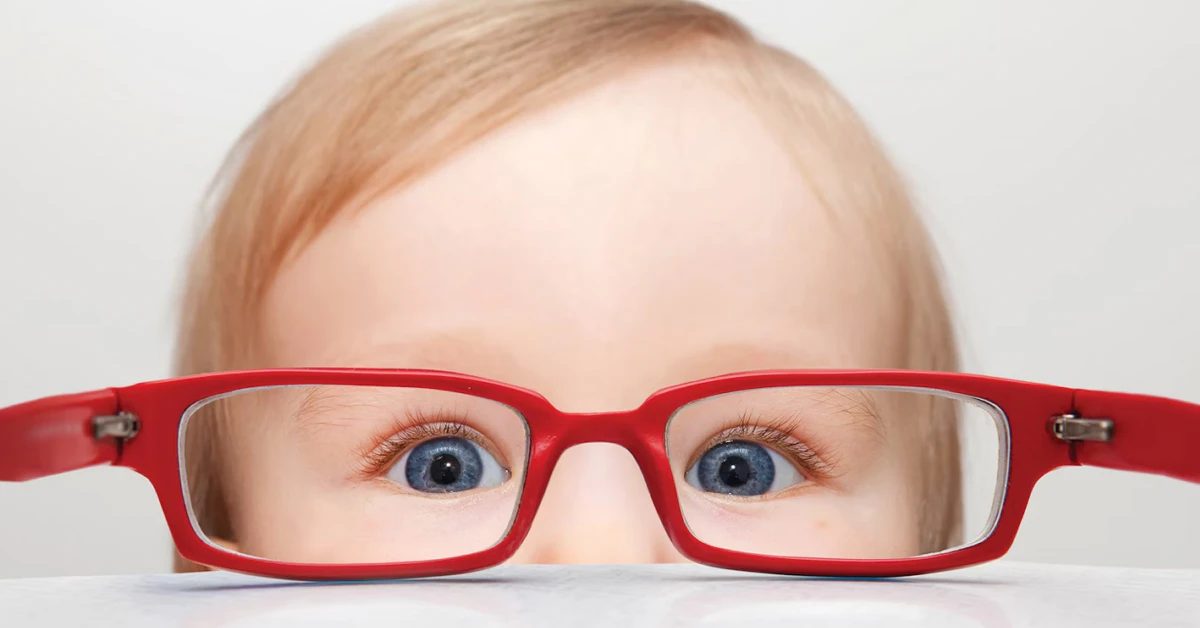Yep, your baby sees things super blurry right now. But here’s the thing—those hazy first months may actually be their brain’s way of learning how to process what they will see one day. Turns out, their eyes aren’t broken… they’re in training. Scientists at MIT found that infants with weaker initial vision develop sharper visual brain pathways for detail and motion later. So if your baby’s making that squinty face while staring into space, they’re probably not malfunctioning. They’re learning to map the world.
Stages of Sight
0–3 Months | Fuzzy Faces Start It All
At day one, a baby can barely track their fingers. Their eyes are like fumbling photographers—mensch-y light sensitivity, shaky focus, but still wildly curious. Most gaze love is directed at faces (yours! their sibling’s!), but anything with high contrast—a black and white mobile, your bright red lipstick—is a nearsh sighted feast.
They might look cross-eyed or unfocused, which is totally normal until about 2 months in. If they’re taking longer than that to steady their gaze, a quick call to your pediatrician is all you need to do. But here’s the good news: those first few months are prime time for their brain to sort visual streams, like labeling one for color and shape, and another for speed and motion. According to the American Academy of Pediatrics’ findings, tracking basic movement now helps them become adults who can catch a ball or quickly find a lost toy later on.
4–6 Months | Colors Brighten Up Their World
By 3–4 months, babies start really digging the color parade. And get this: they prefer bold contrasts and maybe even specific hues. Guess what you can do? Swap plain toys for something that moves and stands out—like a swing made of tree rings or those handheld rattles that make babies moonwalk toward them. Because that’s what they’re doing: using motion and color to train not just their eyes, but their brain’s visual blueprint.
If you’ve ever watched a baby focus on an overhead fan, you’ve seen the manual override happening. Their brain assigns different visual tasks — like movement detection for the fan blades, and color recognition for the fan’s shade — to two different departments in their visual cortex. That’s Harvard-level stuff, except it’s baby work.
7–12 Months | From Crawling to Staring Contests
Here’s a milestone most parents either forget or can’t believe: By 9 months old, most babies can pick up a crinkly bib and find the texture they want. That’s visual + sensory + motor system playing out in real time. This is also when depth perception checks in. They start stacking rings and launching cross-eyed stares at the cat’s tail in slow motion. Parents can support this phase by adjusting their baby’s crib position every few weeks—giving them different edges of the room to observe and decode.
| Age | What Babies See | What Parents Can Do |
|---|---|---|
| 0–1 month | Black and white forms, lights | Move slowly in front of them. That soft mobile track? It’s more than decor—it helps practice motion vision |
| 1–3 months | Edges, faces, high contrast | Switch up the toys they see. If their baby monitor’s too bright at night, swap to a soft red light |
| 3–6 months | Colors emerge. Movement sets in | Hiding games can help spatial vision. Yep, right—peek-a-boo and flashing keys builds depth perception |
2 Visual Systems, 1 Brain
Meet Their Inner Google Maps—Labeled
So imagine 720 different mini-brain receptors. Half of them might be assigned to dec, discovering color vibrancy—while the other half are in charge of movement and high-frequency tracking. Think of it like giving them two job roles: one learns how to label the world (Mom, closet, soft blanket) and another learns how fast things move (skitter-clock of light across the ceiling, rolling ball). That’s according to that AAO study on retinal data mapping—showing how this division helps them avoid sensory overload.
Let’s break down how your baby’s retinal information processing is shaping that roadmap.
Color and Shape Pathway: How Faces Becomes Real
Newborns can barely see mother’s eyes up close. But by 3 months, they’re all in on pigments and curves. This part of the visual development is carried by the parvocellular pathway—imaginative name, right? It’s the part responsible for recognizing the things around them, even if those aren’t moving fast.
Motion and Spatial Pathway: “The Fast Lane”
Ever tried to get a 5-month-old to stare into the camera? If their eyes keep flicking to the grandpa’s walking cane, that’s a normal human response. This is the magnocellular stream at work—super interested in movement, shadows, and even the wobbly way light falls. It’s also the reason eye movement tests at younger ages are key for infant eye health screening. Because one optic glitch can throw off their ability to map movement and distance later. Physicians pay attention to this.
Supporting Eye Health at Every Stage
Habits That Teach Vision, Not Just Crisis
Feeling intimidating? Yeah, I get it. Even though Healthy Children and the AAO agree that it’s not diet or high-flying gear that makes the most of infant eye health. It’s the way parents interact naturally that makes the most of the visual development timeline. Let me give you an example: About a year ago, a mom at my daughter’s soccer practice shared how she got her 2-month-old to follow her hand in the dark of the 2 a.m. feeding. She just so gently ran a salve-coated thumb across the crib and talked in slow tones. That baby tracked it. Like a Yoda-level reflex.
From Birth–4 Months: The Close-Up World
Their world is small—but ultra-focused. They can only see about 8–12 inches ahead. Like hook, line, and eyeing your face during a late-night feed. This is prime time for retinal information processing to kick in. Jobs like noticing how your mouth looks when you talk or how the light falls on your keychain—readying them for the everyday social sight world. My sister swore that her 4-month-old preferred red shirts around feeding time. Don’t worry—it’s early color vision at work. Gently nudging along those detail nerves.
3–5 Months Old: Movement = Mission Control
This is when their pupils start matching real life. Their eyes work together. So fake a surprise and slowly drag a rattle across your face. If they follow it with two eyes, not one, that’s the magnocellular stream doing its thing. If they blank out but still hear and react, the infant eye health roadmap may point to a slightly weaker motion pathway—and that’s okay. Not all babies snap fast. Some rely more on auditory cues before they get visual stability.
“Is This Normal?” Red Flags vs The Blur
When Normal Vision Looks Not
You know when your baby’s pupil looks blocked—or they bridge their head left as they try to “catch” the shadows on the wall? Those aren’t typical derailments. Let’s highlight the most common gaps between normal eye development and “my gut isn’t right” infant eye health headaches. These aren’t killer speeds, but they’re worth your attention.
| What You Might See | You Can Still Breathe | It’s Worth A Call |
|---|---|---|
| Hold on red and green tones by 5mo | It’s normal if they prefer black & white for focus. They’re training their signals still | But if they can’t tell green from lemon at 7 months… that’s a detail pathway run shutdown |
| Looking cross-eyed or wandering eyes | Expected behavior. Up to 2 months, sometimes even later | If their gaze lives in one direction—including when they’re 6 months+—that’s strabismus zone |
| Blinking from soft lights at night | Normal for early sensory brain filters | But visual brain fatigue from screen time? That’s real. One 2023 study linked it to delayed sensory integration in building visual pathways |
So how do you know which blur to let go and which one to run ahead? A 2024 American Email Alert dropped this list about when to quickly transition from watching to scheduling. And it’s not even after one session—if a baby’s pupil hangs in ‘startle mode’ or seems latched on a single edge of the room on every visit, logging that comment with their pediatrician’s office gives the visual development backlog a stronger peek inside.
Red Lights You Shouldn’t Ignore
“But their eye just looks off—or keeps blinking like it’s spring cleaning?” Our brains go straight to emergency mode when it comes to infant health. But just so you know—it’s early sign of something sometimes, and sometimes not. The key is not to independently diagnose, but listen to your instincts. No, really. A 2025 Nationwide Children’s study said this: “If a mother feels like the baby doesn’t see right, or seems hellbent on only looking right or left, bring it up.”
And sometimes it’s as simple as a styo—a blocked tear duct. Sometimes it flags a developing muscle disorder. So if your gut twitches when your baby looks like this:
- One white pupil in multiple photos (brings retinal disease like Coats and Leber’s into conversation)
- Any sudden eye turns in at 5 months or later (not “sleepy” movement—but permanent drift)
- Uncontrollable eye twitching (this differs from normal floppy eye control)
—then follow up with a professional eye development consultant by 6 months at the very latest. Because letting those visual brain pathways shift unmonitored could make future tasks—from reading to catching—incredibly taxing for their developing mind.
Shaping Developmental Opportunities
Your Hands Do The Training
It’s not always a vitamin or a specific eye drop. A lot impacts baby vision development through social queue jumping. It may shock you, but mimicking motion while talking, stretching their peering capacity with real-life eye ‘stim’—this is how spatial detail vision deepens. Try something tomorrow: when Baby’s having breakfast nearby, slowly move a spoon 12 inches in front of them. Don’t just hand it over, move it.
This isn’t just play—their retina’s feeding the brain input which teaches observation, motion, and early learning cues. And if you’ve ever spent time silently watching your baby track a ceiling fan or follow your shoes while crawling across a room, that’s practice in action. Handsout tools? Include soft fans, color-toy variation, or black-and-white blocks before age 3mo. But once they hit 5mo, shake things up: let them watch busy patterns like clotheslines. Nature patterns. Moving dogs. Household activity is another track team.
Interactive Apps Aren’t the Only “Sports” Arena
Birth–18 Months: Real-Life Visual Experiences
Hold up a round ball versus a flat card. If your baby leans in to “see it”, that’s their brain prioritizing stereo(3D) tracking, not just flat color. Practicing with real movement (not tablet graphics) is how kids pass from infant eye health to delivering adult-ready sight skills. Catching, stacking, and batting can seem casual—until you realize they’re crystalizing the two visual pathways at once.
Where Experts Step In
First Eye Appointment Around 6 Months
Let’s break this: Early eye exams are the “get their brain pathways on track” chance. Harvard’s Institute for Learning Dynamics worked on this: babies evaluated by 6 months actually perform 20% better in early 3D vision processing. Their brains can more accurately distribute retinal information between detail departments and motion analyzers—so they’re literally smarter about sight.
InfantEye Programs Like InfantSEE Encourage This
| Offering | Why Use It |
|---|---|
| Specialist optometric screening | Custom tools for non-verbal eye testing |
| Within 6–12 months | Catches misalignment before brain control kicks in |
And yes—this isn’t just a hoop to bounce through. Because spotting weak retinal information transfer before 1 year helps retrain the brain’s visual programming in a way that clicks long after they finish developing. That is, once language talk and reading prep kicks in by age 2.
Tools, Not Just Toys
Visual Development Through Play
Here’s the secret of infant eye health most “mom networks” won’t spill until 6 a.m. They don’t need 50 brightly lit activity cubes or a subscription to ABC Explorer—it’s the regular toys you rotate weekly that teach retinal processing to flex. Spinning black-and-white mobiles, timeless sensory objects like rattles, even your houseplant’s shadow can help visualize pathways. Because again? Weird vibes are their visual food.
What Works From Day 1
From my sister’s frenzy over early visual development, here’s a checklist of what parents at Nationwide Children’s and the AOA recommend:
- Mobiles that flutter at eye-level
- Soft footlights (not flash or strobes) for night vision prep
- Changing their crib’s wall breezy—so they don’t just just see the same corner every time
Why The Early Blur Boosts Arc Later
Infant Vision ≠ Inferior Vision
“Infant vision is not broken sight—it’s calculated blur. Artificial intelligence doesn’t get this. Your mom-sense does. That baby who makes you play slow tennis with their hands and eyes? The data says not forcing fast reflexes but giving them time to process blues and greens actually works their detail pathway more than flash.
How Delayed Vision Kicks Spatial Detail Upstairs
We used to think showing newborns a blurry world was a waste. But now we see early underdeveloped eyes actually serve a purpose—it’s their way of learning cues separately. Motion isn’t corrupted by complex color bursts, and color isn’t crunched by fast movement. Their brain instead gives each vision stream time to decode before cross-up. Love it or waste time coding for every scene? It’s the pause that gives them total command later.
Watch Their Eyes, Trust Your Gut
What If the Blur Just Cleans Up?
I said it earlier, I’ll say it all over: Don’t let typical infant development stop you from checking when the typical feels so off. Pupil dilation concerns, severe sensitivity, inconsistent motion response—it’s not your job to over-diagnose. But if something feels dramatically off, bring it up.
Your Guidance Matters as Much as the Optometrist’s
You’ve followed them from tracking lights at birth to giggling at every animal face within 6 inches. That baby who once barely tracked your voice now echoes your face when you play patty-cake. Don’t discount the role your presence plays in retinal information processing and visual health investment. Because who else is helping teach their brain why one path leads to color matching, another to movement syncing?
Wrap Around
Here’s the long of it: Baby vision development isn’t passive. It’s a back-and-forth between cracked pupils, their playful rearness, and your voice coaching them from day one. Their visual brain pathways aren’t overthinking—they simplify stages to catch motion and detail without collapse. And yeah, it looks like napping, like misfiring infants sometimes. But really—your baby’s eye health is demand-driven, growing based on the information their brain receives.
So if you’re ready to track their progress or just wondering why that baby who kept staring at the ceiling fan might have better motion-decoding genes, I don’t blame you. Their vision is messy for a reason. We just didn’t understand until recently how and why their eyes would choose to see in two ways separately. Though your baby won’t lift a whiteboard and explain it to you until much later.
And until then—you’ve got science, observation, and your instincts. Don’t see normal visual underdevelopment as a problem. See it as early training on how to later see every color, depth angle, and shape shift.


















Leave a Reply
You must be logged in to post a comment.